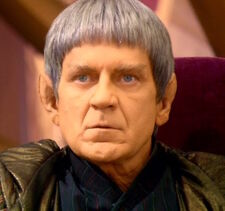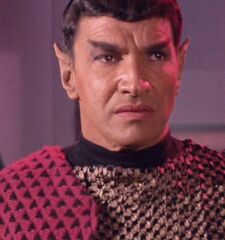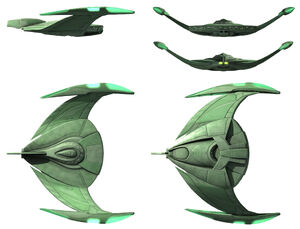The Romulans are major antagonists in the Star Trek franchise. They are descendants of a dissident group of Vulcans who had left Vulcan thousands of years ago. For many years the Romulans were hostile towards the Federation, having never truly been defeated nor allied, though they did join forces with them in the war against the Dominion. Relations significantly changed after the Romulan sun went supernova, with the survivors eventually rejoining their Vulcan cousins and wanting to remain in the Federation even after their Vulcan cousins decided to leave.
It is worth noting that the Romulans were one of the few central alien races in Star Trek to avoid allying with the Federation until the destruction of their homeworld. Even when hostile to the Federation they were far less destructive than antagonists such as the Borg - Romulans also play a large role in recent updates to Star Trek Online, which is set in an alternate-universe from the mainstream Star Trek titles. The Romulan Republic in the game, which is thought to be a "terroristic cell" by the Romulan Empire, however, can choose to ally the Klingon Defense Force or the Federation, depending on the player's choices.
Biology[]
Owing to their heritage as a group of dissident Vulcans who left their homeworld and settled on new worlds, Romulans have a striking resemblance to Vulcans. Over the centuries the Romulans became a distinct subspecies to the Vulcans, with there being a number of differences between them and their baseline Vulcan cousins. They still shared the same pointed earns and copper based blood that appeared green when oxygenated, but by the 24th century there was enough differences that Vulcans were no longer considered as compatible donors for transfusions.
The Romulan species consisted of several different subtypes. Among these were Romulans with pronounced ridges on their foreheads, and other Romulans with smooth foreheads that were outwardly indistinguishable from Vulcans. As Romulans with forehead ridges had originally tended to settle in the northern regions of the planet, other Romulans tended to refer to such Romulans as northerners.
Society[]
In Romulan society, military/political rank influences social standing. Because Romulans were members of a militaristic civilization, who considered defending the Romulan Empire and their own personal honor of foremost importance, military service and its accompanying rank were decisive factors in determining social eminence. However, while the military played an important role in Romulan society, it was the Romulan Senate that controlled the government.
Romulan society was based upon a highly structured caste system. Unlike most of the highly evolved species in the Alpha/Beta Quadrant, Romulans still practiced slavery, in this case of the Remans, which they used for slave labor and as shock troops.
Romulans tend to be highly xenophobic, engaging in extended periods of isolationism, and could be perceived as outright racist to other species, believing themselves to be superior. At least some Romulans believed that, one day, the Romulan Empire would rule the entire galaxy and that Humans would be extinct. (TNG: "The Neutral Zone", "Data's Day", "The Enemy") According to Miles O'Brien, there was no piece of technology in existence that the Romulans didn't claim they invented before everyone else.
Both males and females could command warships, obtain high political positions, and could be members of the Tal Shiar.
Northerners (those Romulans with ridged foreheads) tended to dominate in Romulan politics and society. At some points in Romulan history the entire Senate would be comprised entirely of northerners. Northerns were often seen by other Romulans as stubborn.
At one point in their history, Romulus was a sovereign nation ruled by an Empress or Emperor. By the 23rd century, the highest position of power was held by the Praetor, who presided over the Romulan Senate. The Praetor headed the Continuing Committee, which was comprised of the Empire's most elite individuals, who made decisions of the utmost importance. While there was a Romulan Emperor as late as the mid 24th century, that person was mainly a figurehead, with the actual power belonging to the Praetor and Committee.
By the 24th century, the government of Romulus was dependent upon the Tal Shiar, the Romulan secret police, to maintain order and stability among both civilians and the military. The Tal Shiar was known for its brutal tactics, which included routine kidnapping, torture, and assassination. Many Romulans feared even expressing dissenting opinions in order to not bring the attention of the Tal Shiar. There were also indications that tension existed between the military and the Tal Shiar.
History[]
Early History[]
The Romulans share many of the concepts and titles as the ancient Romans and Greeks of Earth - such as Praetor, Emperor, Senate, Erebus, and so on. This has led Federation scientists to believe the advanced alien Apollo and others who visited Greece several thousand years ago had visited Vulcan as well in the distant past, and thus were a major influence in the proto-Romulan people.
The idea of a group of Vulcans leaving for a new world was initially an idea that Surak and his followers came up with. Feeling that Vulcan was at the edge of another war which would destroy the Vulcan race, Surak and his followers began making plans to leave Vulcan to ensure that at least some of the Vulcan race would survive.
Late, in the 4th century CE Vulcans "who marched under the raptor's wing" left Vulcan in a group of 18 colony ships. Among the leaders of this group were Vulcans like Surak's friend and former student S'task, who had initially embraced Surak's philiosophies until a group of Orions tried to enslave him and he was forced to kill them to escape. Over the next century they wandered the galaxy in search of new home. Several groups broke away to form their own societies. This included the Debune - who were named after Admiral Debrune - and a group that settled in the Rigel system. Illnesses such as lunglock took a heavy toll on the group. Eleven ships in the fleet were lost before reaching their final destination.
One of the others who left Vulcan was the warrior Garamond, who had taken possession of the Ko N'ya - also known as The Devil's Heart - after Surak gave it up. Garamond brought the stone with him to Romulus.
After a century of wandering the seven surviving ships reached a pair of worlds which they claimed as their own. Establishing themselves on the new worlds the exiles became the Romulans and Remans, with the Romulans taking possession of the class M world Romulus, and "undesirables" forced to live on the class Q world Remus. These "undesirables" were often the exiles who wanted to maintain Surak's beliefs and practices after a century of wandering.
S'task was one of the first leaders on the new world, but he was killed at the order of the T'Rehu. After the death of people like S'task the Romulans embraced a power-hungry philosophy centred on military aggression and imperialism, they have been behind the scenes in many of Star Trek's more prominent conflicts and their animosity with the Federation has lasted generations.
Garamond also became one of the leaders on the new world which came to be known as Romulus. Over the remainder of his life he consolidated his power, becoming one of the most powerful kings on the new world. When he died his mistress was able to sneak the stone out of Garamond's fortress and take it to her family home. She then spent her remaining years using the Ko N'ya's powers to form the Romulan Star Empire and take her people back to the stars. The Ko N'ya was lost to the Andorians when a Romulan attack on Andoria failed and the Ko N'ya thought the Andorias would be better hosts.
During the 13th century one of Q Continuum member Quinn's attempts at committing suicide caused a misunderstanding between the Romulans and Vulcans that led to near a century of warfare between the two races. Other than that, there had been only limited contact between the two races until the 22nd century. By the 22nd century most Vulcans knew little of the Romulans other than that they were a hostile species, and did not know of their relationship to the Romulans. The Romulan language diverged enough from Vulcan that by the 22nd century it was an entirely separate language that most Vulcans were not fluent in.

V'Las, a Romulan deep cover agent.
In the 21st century, as the Romulans rediscovered their origins they began a long term program of undermining Vulcan society and steering them away from Surak's teachings to make them more warlike and more easy to conquer. Deep cover agents were sent to Vulcan to infiltrate Vulcan society at all levels, including the highest levels of the Vulcan High Command. Over the next century these Romulans secretly influenced their Vulcan cousins to be more warlike.
Feeling that the telepathic abilities their Vulcan cousins had would put them at a disadvantage, Romulans used faked medical research to convince large segments of Vulcan society that mind melds and other telepathic arts were inherently dangerous and unnatural. By the mid 22nd century most Vulcans felt it was uncouth and unnatural for Vulcans to meld with each other. Due to Romulan interference, much legitimate Vulcan research into the telepathic arts was lost, and there was a marked increase in Vulcans suffering from mental health issues. It was not until the Syyranite reformation of 2154 that melding became socially acceptable again. Mental health diagnoses decreased markedly once Vulcans were able to meld again without fear of being ostracized. However some older, conservative Vulcans still disapproved of mind melds well into the 23rd century.
Encounter with the Humans[]
Romulans had been aware of Humanity for some time before Earth knew of them. The Romulans were impressed and seemingly confused by humans. Enterprise NX-01 inadvertently encountered a Romulan minefield at one point, officially the first time humanity became aware of the Romulans. Even after fighting the Earth-Romulan War, it wasn't until the 23rd century that humans actually made visual contact with Romulans.
In the mid 22nd century, the Romulans fought a war against Earth and its allies, with the Romulan Admiral Valdore in charge of the military efforts. Hard fought the Romulans were unable to defeat Earth or their allies. Retreating behind a treaty negotiated neutral zone they licked their wounds and built up strength to the point where they could attack again. The Romulans avoided visual contact with humans and their allies as much as possible. While Section 31 and a few others in Federation government knew what the Romulans looked like and their origins as an offshoot of the Vulcans, most of what became the Federation had no idea what the Romulans looked like or their true origins. (Encountering a joined Trill for the first time, one Starfleet doctor in the 2160s wondered if the symbiont was a Romulan).

A smooth headed Romulan commander of the 23rd century.
| “ | Vulcan, like Earth, had its aggressive, colonizing period - savage, even by Earth standards - and if the Romulans retain this martial philosophy, then weakness is something we dare not show. | „ |
| ~ Spock advocating a military response to a Romulan incursion. |
A century later Praetor Vrax ordered a ship sent to probe Federation defenses in preparation for a full scale attack on the Federation. The ship was disabled by the Enterprise before they could return home, with the Romulan commander committing suicide before his ship could be captured. Before committing suicide the Enterprise established visual contact with the Romulans, marking the first time a human and Romulan visually communicated with each other, and making the Federation at large aware of the link between the Vulcans and Romulans.
After the Treaty of Algeron went into effect in 2311, the Romulans retreated into political and social isolation from the galaxy at large. In the 2340s Romulans attacked Klingon colonies, including those at Narenda III and Khitomer. The sacrifice of the Enterprise-C in defending Narenda III against the Romulans shored up the relationship between the Empire and the Federation.
| “ | Do you understand my meaning, Captain? We are back. | „ |
| ~ Commander Tebok to Captain Picard |
In late 2364, an unprovoked attack on a Romulan outpost near the Neutral Zone occurred. The Romulans initially suspected the Federation had executed the attack but upon seeing the level of devastation for themselves they realized it could not have been the Federation. The Romulans sent a warbird to obtain information from the Federation, Captain Picard was able to convince them to share the information on the attacks as the Federation had suffered similar attacks. This event marked the end of Romulan political isolationism with the larger galaxy.
Reunification[]
In the 24th century, Spock learned that some Romulans wanted to learn the Vulcan ways. He undertook a personal mission to Romulus to explore the possibility of the reunification of the Romulan and Vulcan people. Having learned of Spock's visit, the Romulan government tried to use Spock to expose the other members of Spock's movement, and to invade Vulcan. With assistance from Captain Jean-Luc Picard and Commander Data Spock was able to prevent the invasion of Vulcan. He elected to remain to help the Romulans who were taking their first steps towards a Vulcan way of life.
In 2387 Romulus was destroyed when the Romulan sun became a supernova, leaving the survivors scatterd and the Empire largely destroyed. Spock himself disappeared into a black hole created by red matter. While this actually sent him back in time to the mid 23rd century, the prime reality assumed he had died in the incident. Some time after Spock departed the prime reality, Spock's goal of reunification came to pass when the descendants of the survivors reunified with their Vulcan cousins and joined them on Vulcan, which was renamed Ni'var. Spock came to be highly regarded both by the Vulcans and Romulans. In the years after the Burn, Ni'var left the Federation, even though the majority of the Romulan population wanted to remain in the Federation. The combined Romulan and Vulcan people rejoined the Federation in 3190.












